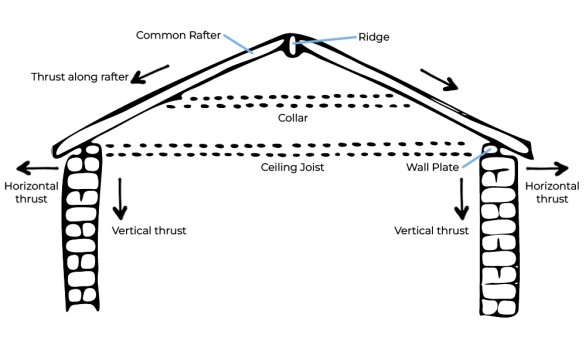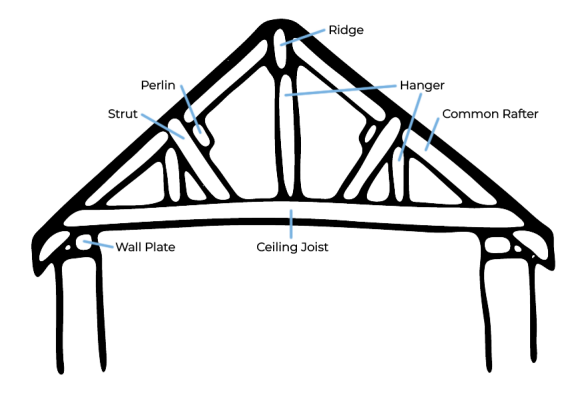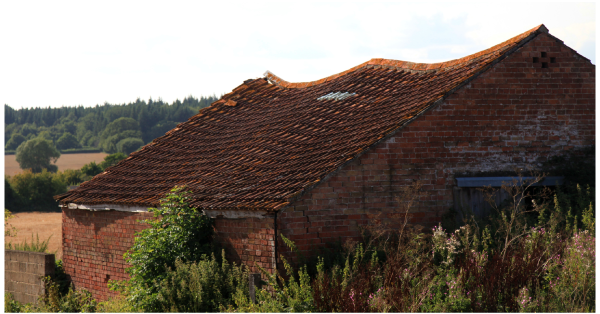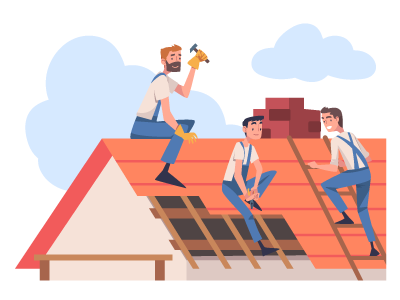Buying a House With Roof Spread
- Roof spread is commonplace in older Victorian-style houses, mainly because they used a simple design.
- The spread is caused by inadequately supported rafters, they typically open in a scissor-like pattern, which may push the tops of supporting walls outwards.
- Correcting spread issues can be expensive, especially if it involves extensive reconstruction work.
- Top Tip: Use your survey report to negotiate the purchase price with the seller. You may be able to pay less for the property to offset the cost of repairing the roof after purchase.
Purchasing a home is a significant investment; so, you should always consider the condition of the property. One structural issue that you may come across is roof spread, whether that’s been flagged in a survey report, or you have noticed it yourself, understanding how to manage this problem is crucial.
It's a common occurrence with traditional-style properties and one of the more visible structural issues for a building; found on a lot of roofs of historic buildings.
In some cases, roof spread can be a serious cause for concern, especially if it is left unmonitored. A good roof will last longer than a lifetime, but a bad one could fall apart within weeks of being installed.
What is roof spread?
A roof is usually comprised of two rafters and a ceiling attached to two wall plates. This forms the universal triangle shape we all know of when thinking about a roof.
Wooden bars are then rested vertically on top of the two ridge beam rafters, and the roof covering is fitted over the top of everything.
Generally, in older homes, two beams are leant against one another and secured at the tip to prop up the ceiling – this is the most straightforward design which provides more roof space, but the modern strategy is now to opt for the use of trusses, providing the structural outline to support the roof.
Roof spread happens when the weight of the roof pushes downwards and outwards against the rafters and with enough force, the whole structure moves. This is a slow but persistent process and will either involve the roof pushing downwards or the walls pushing outwards, with the horizontal thrust affecting the property's external structure.

If the horizontal thrust is not restrained, the structure is not stable. With proper reinforcement, the horizontal thrust can be restrained and redirected vertically.
How common is roof spread?
It is commonplace in older Victorian-style houses, mainly because they used a simple design to help prop up the ceiling and used a raised tie beam roof truss to increase the height of the internal ceiling.
Since the tie beams hold the base of the triangle together, when it is raised upwards it puts a massive amount of pressure on the rafters which means the rafters need to be bigger.
In our recent survey, 16% of homeowners found defects; including 2% who were able to pull out of a bad purchase, 7% who were able to negotiate a better price, and sadly, 7% of homeowners who did not get a survey and discovered defects after the purchase.
12 of the 39 who remembered how much these defects cost to remedy spent over £5,000
Don't burn your money, book a survey.

Back when Victorians were building houses, they could get away with this type of roof structure, because roofs were regularly made with lightweight slate.
Lightweight materials could resist spreading, but once these slate roofs reached the end of their life, they were replaced with cheaper concrete tile roofs. This is where the spread occurs: the weight and downward pressure on the rafters cause this since the rafters were not designed for concrete.
Modern truss rafter roofs were almost universal by the 1970s, so this problem is rare in houses built post-war.

The signs and cause of roof spread
Detecting spread can be challenging, especially if you aren’t a structural engineer or a professional surveyor.
The first signs to look out for would be:
- Cracking – cracks appearing above windows, doors, or in the walls, particularly if they’re in upper stories.
- Bulging – the exterior wall bows with outward movement due to horizontal thrust.
- Sticking doors or windows – frames that are difficult to open or close could be due to misalignment.
A sagging roofline is another sign to watch out for, so if you notice that a roof is dipping or curving, the rafters have almost certainly started to buckle under the downward pressure.
Since spreading is caused by inadequately supported rafters, they typically open in a scissor-like pattern. The rafters are attached to wall plates sitting on a masonry wall, so the principal rafters are pushed out and therefore the masonry wall plate too.
A professional surveyor can correctly identify these signs and will include them in a detailed report, confirming whether it is an issue or not.

Implications on the roof structure
Buying a property with roof spread has several possible implications:
Structural stability – this is the primary concern of anyone involved with the property. Severe spread could lead to partial or complete structural failure.
Repair costs – correcting roofing issues can be expensive, especially if it involves extensive construction work.
Insurance – insurers may be reluctant to cover a property with well-known structural roofing issues, or they could demand a higher premium.
Is it worth the investment?
Depending on the extent of the damage, buying a property with roof spread could be worth the risk. Minor roofing issues might be manageable with reasonable repairs, but severe cases could be too excessive in costs.
In the right location and market, investing in repairs to a desirable property might yield a high return on investment.
However, it’s imperative to ensure you have the financial capacity to handle any unexpected costs that arise during the repair process.
Should I buy a house with roof spread?
Here are the steps to take if you are interested in purchasing a property with roof spread:
- 1Get a detailed survey – instruct a surveyor to assess the extent of the damage and speak with a structural engineer to get an idea of repair costs.
- 2Negotiate the purchase price – use the survey report to negotiate the purchase price with the seller. A reduction in the price might be beneficial to offset the repair expenses.
- 3Specialist repairs – hire an experienced contractor who specialises in structural roof repairs to handle the remedial works and ensure it’s done correctly.
- 4Cover yourself with insurance – shop around with different insurers willing to cover properties that have had structural repairs. Make sure to read the terms and conditions carefully.
Jack is our resident Content Writer with a wealth of experience in Marketing, Content, and Film. If you need anything written or proof-read at a rapid speed and high quality, he's your guy.
Caragh is an excellent writer and copy editor of books, news articles and editorials. She has written extensively for SAM for a variety of conveyancing, survey, property law and mortgage-related articles.









